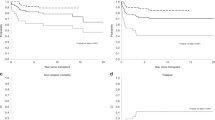Abstract
The purpose of this study was to investigate the results of high-dose therapy and autologous stem cell transplantation in adult patients with Hodgkin’s disease in first relapse after chemotherapy, to determine the overall and progression-free survival, identify prognostic factors for outcome, and to define the role of conventional dose salvage therapy given prior to the high dose regimen. A retrospective analysis of 139 adult patients reported to the lymphoma registry of the European Group for Blood and Marrow Transplantation (EBMT) between February 1984 and July 1995 is considered. Data on all patients were reviewed and prognostic factors determined in univariate analysis. The actuarial 5-year overall survival (OS) and progression-free survival (PFS) for the entire group of 139 patients were 49.4 and 44.7%, respectively. In univariate analysis for OS, disease bulk at the time of high-dose therapy, second-line regimen, initial remission duration and status at transplant had no predictive value. Status at transplant was predictive for OS when patients in second complete remission (CR) were analysed separately from those in chemosensitive relapse. Similar trends were observed for PFS. We concluded that high-dose therapy and autologous stem cell transplantation is an effective strategy for patients with Hodgkin’s disease in first relapse after chemotherapy. These results suggest that it should be used regardless of initial remission duration. The role of conventional-dose salvage given prior to high-dose therapy is unclear, since disease status, disease bulk at the time of transplantation, and the second-line regimen had no significant effect on outcome. However, in view of the low patient numbers, no firm conclusion is possible, and this issue requires prospective assessment.
This is a preview of subscription content, access via your institution
Access options
Subscribe to this journal
Receive 12 print issues and online access
$259.00 per year
only $21.58 per issue
Buy this article
- Purchase on Springer Link
- Instant access to full article PDF
Prices may be subject to local taxes which are calculated during checkout
Similar content being viewed by others
Author information
Authors and Affiliations
Consortia
Rights and permissions
About this article
Cite this article
Sweetenham, J., Taghipour, G., Milligan, D. et al. High-dose therapy and autologous stem cell rescue for patients with Hodgkin’s disease in first relapse after chemotherapy: results from the EBMT. Bone Marrow Transplant 20, 745–752 (1997). https://doi.org/10.1038/sj.bmt.1700963
Received:
Accepted:
Issue Date:
DOI: https://doi.org/10.1038/sj.bmt.1700963
Keywords
This article is cited by
-
Rituximab as adjunctive therapy to BEAM conditioning for autologous stem cell transplantation in Hodgkin lymphoma
Bone Marrow Transplantation (2022)
-
High-dose chemotherapy and autologous stem-cell transplantation in Korean patients with relapsed or refractory Hodgkin lymphoma
International Journal of Hematology (2013)
-
Monoclonal B cells detected in autologous PBSC grafts from patients with classical Hodgkin lymphoma: impact on relapse and survival following transplantation
Bone Marrow Transplantation (2010)



